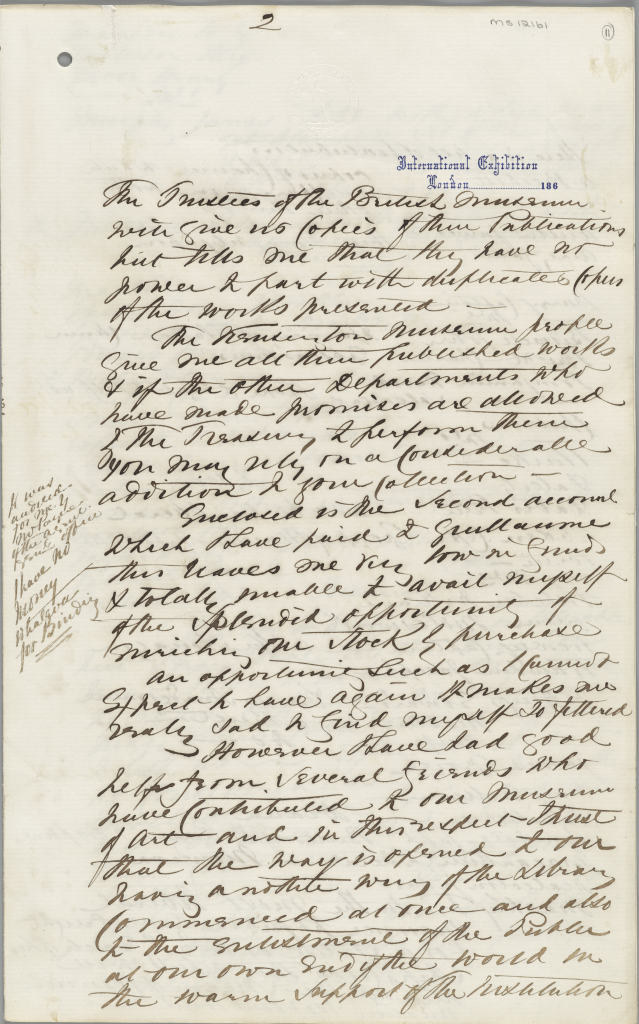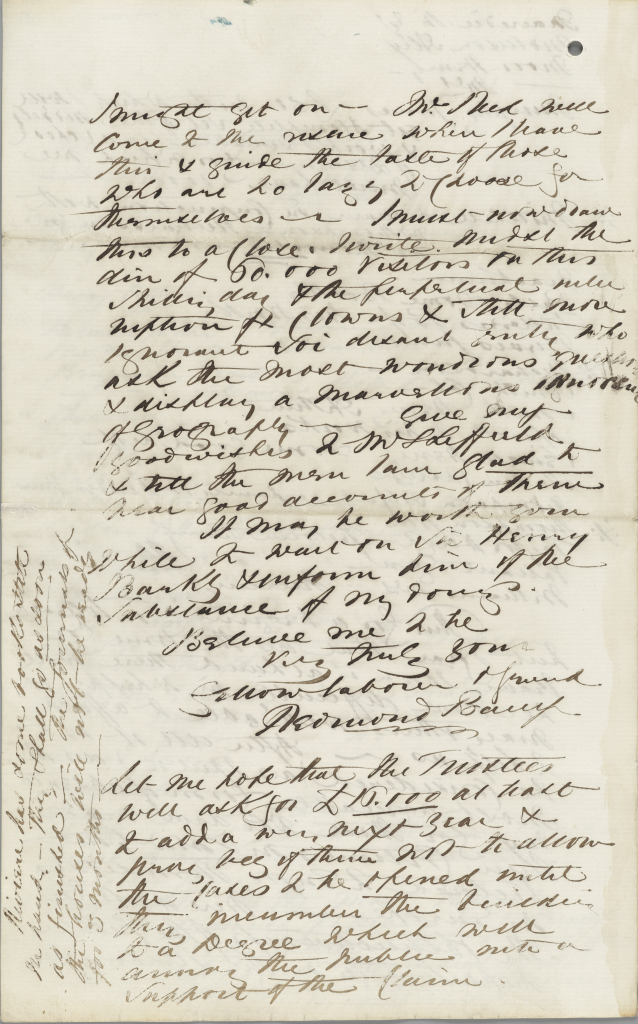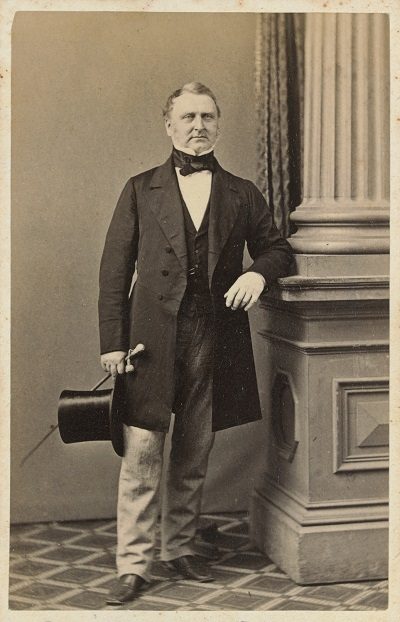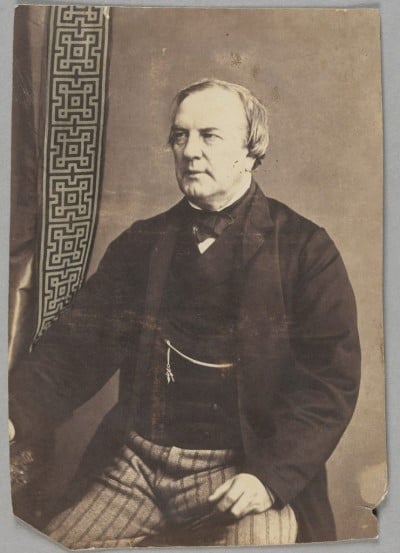Sir Redmond Barry and Augustus Tulk are significant figures in the story of our State Library, as the first President and Chief Librarian. But what was their relationship like? While they did not have a background in libraries, they shared a passion and dedication for the vision of a public library for all, a love of books, and experience of the impact that access to books can have on people and society.
From secondary sources, we learn that they became ‘excellent’ friends,1 2 through their scholarly pursuits. While Barry’s background was the law, he was widely read, favouring the natural and human sciences.3 Meanwhile Tulk, ‘the son of an Englishman of means’,4 received a classical education and later studied languages abroad, becoming fluent in German, French, Russian and Italian.5 They also worked tirelessly to champion the Library’s reputation and build the collection, taking a carefully considered yet determined approach to the organisation, acquisition and expansion of materials, which extended to obtaining pieces for the original Gallery. On opening in 1856, the Library had 400 volumes on shelf. By the end of Tulk’s tenure in 1873 (his death), this had grown to 80,000. 6 7

However, it is through their original correspondence, including Barry’s letters to Tulk during his travels in Europe attending the 1862 International Exhibition in London (within the Redmond Barry Papers in our Manuscripts collection), that we get a true sense of the underpinnings of their relationship; two kindred spirits with a deeply held respect and loyalty for each other professionally and personally, the most obvious evidence of this in how they address and sign-off their letters. Each begins and ends warmly with ‘My dear Tulk’ or ‘My dear Sir Redmond’ and variations on ‘Believe me to be Yours truly devoted…’. Today’s library staff can also relate to many of the issues the men discuss, still as relevant today as they were then.
Themes include the relationships Barry has made while abroad, the physical and financial donations and procurements for the Library, and the importance of both men working together to make an impression on the Trustees and dignitaries so that the Library can maintain and strengthen its reputation. Ongoing frustrations with the bookbuyer, 8 and Barry’s impressions of the Exhibition and other cultural institutions and its influence on his vision for the Library and the University of Melbourne, 9 are also covered.
The earliest of the letters in April 1862 seeks Tulk’s assistance to send on copies of the Library’s Catalogue to share with other exhibitors.10 Its lack of arrival continues to be mentioned as a source of frustration. Throughout their communications, there are lists of donors, evidence of donations and references to the support of international colleagues. Particular examples indicate the beginnings of a world-renowned collection. Barry writes in one:
I have persuaded all our fellow whom I have yet seen to contribute to our museum some statue, bust, painting, Vase Tazza or other object of art as each may see fit leaving the selection to the taste and fancy of each … When these are completed I will have them placed in a room which we hired for an office of the Exhib.[ition] In Sloane St. and invite the donors to come in and see what they have given us. 11
In another note, Tulk is asked to visit Sir Henry Barkly12 and provide him with a list of UK government publications the Library wishes to acquire, because the cost normally required by the Ministry has been waived for the Library due to
…the popularity it enjoys by the large and increasing numbers resorting to it, and to the opinion expressed by Governor Sir. H. Barkly that it is one of the noblest and most extensively useful in Her Majesty’s dominions’.13
Barry’s letter dated 21 July 1862, expresses his hope that the new acquisitions of art will lead to an expansion of the building.


Pages from the 21 July 1862 letter from Barry to Tulk (MS12161, Box 2781, Folder 4)
While there are only two examples of Tulk’s correspondence with Barry, the most extensive, that also showcases the ornate Melbourne Public Library letterhead, was written on 25 September 1862. In it, he reports that the business of the last meeting of the Trustees and 1863 budget estimates were sent to the Chief Secretary, along with the £8,500 estimate for the building of the North Wing. These were presented to the Ministry, along with Barry’s letters regarding the donations acquired, who listened ‘attentively’ and ‘approved of everything that he said’.
Tulk writes of the representations he has made to Barkly, who has ‘…always been heart and soul with us’, and to Mr Johnston, the Minister of Public Works.14 We learn that even from its earliest beginnings, Library finances could not be assured and the need for advocates in government were important. While Tulk is a loyal servant to Barry, his shrewd observation of the need to seek external support by placing leading articles in The Herald and The Argus, promoting the latest acquisitions, were forerunners to today’s marketing campaigns.


L to R: ‘Dear Sir Redmond’: Tulk’s correspondence with Barry in September 1862 (MS13020, Australian Box 5/7) and July 1870 (MS13020, Australian Box 5/7) .
While Library business is central to their letters, Barry shares his impressions with Tulk while he travels, knowing that he will appreciate them.15 There are enquiries about the upkeep of the Library garden, the weather and personal circumstances. Their friendship is strong, given how they freely express their thoughts and feelings about their work and each other. They value the correspondence and it clearly drove their endeavours, knowing that they were each other’s ally in building the institution we know today.
References
- McCallum, CA, ‘Tulk, Augustus Henry (1810–1873)’, Australian Dictionary of Biography. National Centre of Biography, Australian National University, viewed 19 September, 2023, <https://adb.anu.edu.au/biography/tulk-augustus-henry-4756/text7901>
- Molloy, K, 2018, ‘Edmund La Touche Armstrong – Fifty years of the Public Library: Some recollections and some notes’, The La Trobe Journal, no 101, p 23, viewed 19 September 2023, <http://latrobejournal.slv.vic.gov.au/latrobejournal/issue/latrobe-62/t1-g-t10.html>.
- Ryan, P, ‘Barry, Sir Redmond (1813–1880)’, Australian Dictionary of Biography. National Centre of Biography, Australian National University, viewed 19 September, 2023, <https://adb.anu.edu.au/biography/barry-sir-redmond-2946>
- Molloy, K, 2018, ‘Edmund La Touche Armstrong – Fifty years of the Public Library: Some recollections and some notes’, The La Trobe Journal, no 101, p 23, viewed 19 September 2023, <http://latrobejournal.slv.vic.gov.au/latrobejournal/issue/latrobe-62/t1-g-t10.html>.
- Arnold, J, 1998, ‘Library profile: Augustus Tulk, gentleman librarian’, The La Trobe Journal, no 62, pp 54-6, viewed 19 September 2023, <http://latrobejournal.slv.vic.gov.au/latrobejournal/issue/latrobe-62/t1-g-t10.html>.
- Armstrong, ELT, 1906, The book of the Public Library, Museums, and National Gallery of Victoria : 1856-1906, Trustees of the Public Library, Museums, and National Gallery of Victoria, Melbourne.
- Arnold, J, 1998, ‘Library profile: Augustus Tulk, gentleman librarian’, The La Trobe Journal, no 62, pp 54-6, viewed 19 September 2023, <http://latrobejournal.slv.vic.gov.au/latrobejournal/issue/latrobe -62/t1-g-t10.html>.
- Frederick Guillaume in London.
- Barry was a founder and first Chancellor of the University.
- This was most likely the 1861 catalogue.
- Letter of 20 May 1862, as cited in Galbally, A, 1995, Redmond Barry: An Anglo-Irish Australian, Melbourne University Press, Carlton, p 123.
- Governor of Victoria from 1856-1863.
- Letter from Sir Frederick Peel of 6 August 1862 with accompanying note from Barry to Tulk. Peel was Financial Secretary to the UK Treasury between 1860 and 1865.
- James Johnston was Minister for Public works in the O’Shanassy Government between November 1861 and June 1863.
- Galbally, A, 1995, Redmond Barry: An Anglo-Irish Australian, Melbourne University Press, Carlton.




This is a wonderfully human and delightful perspective on these two library legends.
Hi Mary,
It was a really nice bit of research to do. Thanks.